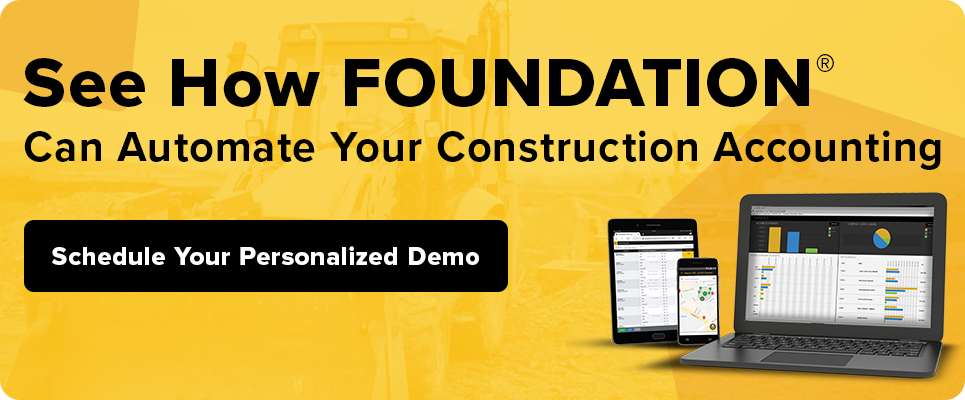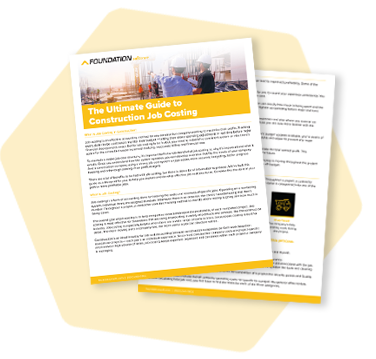
Overhead allocation in construction is a way to share costs across multiple jobs. Why on earth would you do that?
Simple: these are the costs your projects share responsibility for anyway — they’re the costs you’re already paying but can’t easily charge directly to a single construction project. Instead, they’re “indirect costs.” And if indirect costs aren’t tracked properly, it can give you a false sense of job performance.
How do you assign those costs fairly? That’s the goal of overhead allocation.
The more accurately you can measure how overhead impacts each job’s bottom line, the more accurate your picture of job performance can be. This can also mean better data for estimating, which in turn can protect your bottom line on future jobs.

What Is Overhead?
Overhead is typically a broad category of costs that aren’t caused by any single construction project. In broad strokes, you’ll sometimes hear about two kinds of “overhead costs”[*] —
- indirect costs
- general and administrative (G&A) costs
One way you can think about the difference is whether the costs are related to the activity of your projects.
Indirect Costs
Indirect costs are indirect expenses that relate to your job activity. Unlike a direct cost, though, an indirect cost is either:
- tied to multiple jobs or
- necessarily difficult to tie to just one job.
Let’s say Build-It Construction uses ten tons of gravel on Job 110 — if it wasn’t for that one project, the cost wouldn’t exist, right? So that’s pretty clearly a direct cost to that job.
But let’s also say they use a dozer to lay that gravel. Of course it wouldn’t be fair for Job 110 to shoulder all the expenses for that piece of construction equipment like a direct cost. Instead, every project that uses the dozer has some responsibility for it needing oil, service work, equipment maintenance, etc. Therefore, these are indirect costs they might consider as overhead expense.
We can look at another example.
They schedule an engineer for six hours on Job 110 and three hours on Job 210. Again, if Job 110 didn’t exist, six hours never go to payroll — they’re a direct cost to Job 110. Whichever job the engineer works on, however, Build-It Construction still has to pay health care premiums for that engineer. They might treat those indirect costs as overhead as well.
In short, several projects are responsible for the expense, and several projects benefit from it, but not all jobs necessarily relate to it equally.
G&A Costs
In contrast, a G&A cost might be one that applies to the general running of the business. All projects probably benefit from it more or less equally. Examples include:
- Office rent and utilities
- Administrative salaries
- Office Supplies
- Advertising
- General liability insurance cost
- And a lot more!
G&A supports your ability to take on and bill jobs — but in one sense, they’re relatively stable despite fluctuation in your job progress and labor. If you’d still have the expense even if you had no active jobs (rent, for example), that’s likely G&A cost.
In general, showing a connection between one job and its effect on a G&A expense is much harder to make. Imagine making the case that one job resulted in a 3% increase in your copier toner use!
That’s why G&A can sometimes be handled differently from allocated overhead. Your jobs might have different levels of responsibility for overhead, but your jobs aren’t really responsible for G&A. Still, you might choose some fair way to disburse G&A across your jobs just so the reality of those costs are factored in alongside your project revenues.
Your construction CPA will be able to help you figure out which costs are direct, which are indirect, and which are G&A.
They can also take you through whether and how they might want you to account for and allocate each of these differently.
How to Allocate Overhead
Because there are many options in the allocation of overhead, the first rule is to know what you don’t know. A construction CPA can help you determine the best way to allocate your overhead costs. That also includes:
- What costs
- What method
- What technology
These are also three basic steps to successful job costing.
1. Gather Your Costs
First, know what the costs are that you want to allocate. You can ask simply, “What are the real costs of completing this job?” Here’s where thinking through both overhead and G&A types of indirect costs for allocation might become helpful.
In the example of the dozer above, Build-It Construction already knows several jobs are responsible for those equipment expenses: service costs, fluids, possibly depreciation, and maybe even their cloud equipment tracking software. They might also pool these with their other overhead costs like labor burden, or they might keep them in separate cost pools. That way, they can distribute equipment costs more heavily to more equipment-intensive jobs and distribute payroll costs more heavily to more labor-intensive jobs.
You can already see how there’s no single right answer for everyone. Our example company and their CPA can make overhead allocation fairly simple or highly nuanced, depending on the level of detail and accuracy they want to achieve.
2. Select Your Method
Establishing a basis. Part of defining what cost pools you want to allocate to your jobs is also figuring out how you want to distribute them.
Here are just a few options contractors might use as a basis for allocating overhead:
- total direct job costs
- direct labor costs
- direct labor hours
- equipment costs
Selecting a basis for indirect cost allocation should make sense for the type of cost and for your type of business.
A labor-intensive roofing contractor probably shouldn’t allocate their liability insurance based on truck usage. Similarly, imagine a job with a high proportion of your direct costs but relatively low labor; you could use total direct job costs to allocate overhead, but if that makes the project responsible for a large share of payroll overhead, that might not make the most sense.
Along with selecting a basis for your allocation, you’ll need to figure out how you’re going to allocate costs:
Using a predetermined rate. For example, contractors can choose to estimate their overhead for each job using an established overhead rate. For example, you might calculate that your overhead for a job generally represents x% of revenue or y% of its direct labor costs. To allocate overhead, you’d add that amount to your total job costs. While this tends to be a simpler method, it also tends to be less accurate.
Using a proportion among jobs. Alternatively, contractors can track each overhead cost in their G/L and distribute them proportionally across all jobs. A simple example could assign 25% of your total overhead to a job representing 25% of your company’s direct job costs. However, you can add finer-grain complexity by allocating only a set portion from each overhead G/L account or by allocating a greater or lesser proportion to certain G/L accounts.
Read more about overhead allocation methods »
3. Get the Technology You Need for Your Overhead Allocation Process
You hear it all the time: having the right tool is important — because it’s true! Depending on the size of your business, spreadsheets simply may not be a realistic, long-term option for tracking and managing your overhead allocation.
On the one hand, there’s excellent generic accounting software that can work very well for small contractors. But if it isn’t designed to allocate overhead to distinct jobs, you can be stuck doing work outside of the system. That increases the risk of entry error and calculation mistakes. Plus, it means your financial data is stored in more than one place.
Construction-specific accounting software can give you multiple ways to perform indirect cost allocation. Finding the right fit means, in part, making sure that it’s able to facilitate the method you and your CPA determine is most beneficial for you. So flexibility is a factor.
When you begin the search for construction accounting software, talk with vendors one-on-one. Ask them whether their application can help you with your overhead allocation process.

Not every accounting system is going to be a fit for everyone. Finding one that you can implement well with accounting processes that help your success is the most important thing.
See what Foundation can do in a self-guided product tour, and connect with us over a live demo so we can talk about your overhead allocation needs.
[*] If you do government contract work, you might instead hear that “indirect costs” need to be pooled into “overhead costs” and G&A. If you have questions, be sure to talk to your CPA.
Share Article
Keep on current news in the construction industry. Subscribe to free eNews!
Learn about our software more in depth with product overviews, demos, and much more!

Our ACA reporting & e-filing services include official 1094-C and 1095-C IRS reporting, optional e-filing (no applying for a TCC code required), mailing to your employees and experienced support to help you.

There are plenty of reasons to make FOUNDATION your choice for job cost accounting and construction management software — just ask our clients!

From job cost accounting software, to construction-specific payroll. Get an overview on your next all-in-one back-office solution.



